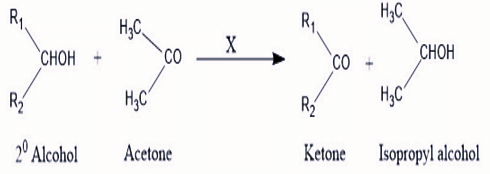Which of the following compounds is most reactive towards nucleophilic addition reactions?
Show Hint
The Correct Option is A
Solution and Explanation
The reactivity of carbonyl compounds in nucleophilic addition reactions is primarily determined by:
The electrophilic nature of the carbonyl carbon,
The steric effects due to substituents around the carbonyl group,
The electronic effects from substituents that may donate or withdraw electron density.
Step 1: Compare aldehydes and ketones. Aldehydes (e.g., \( \text{CH}_3\text{CHO} \), \( \text{C}_6\text{H}_5\text{CHO} \)) have only one substituent attached to the carbonyl carbon, which minimizes steric hindrance and allows easier attack by nucleophiles. As a result, they tend to be more reactive. Ketones (e.g., \( \text{CH}_3\text{COCH}_3 \), \( \text{C}_6\text{H}_5\text{COCH}_3 \)) possess two alkyl or aryl groups attached to the carbonyl carbon, leading to higher steric hindrance and consequently lower reactivity.
Step 2: Examine electronic effects. The inductive effect of the single alkyl group in aldehydes stabilizes the partial positive charge on the carbonyl carbon, but not as effectively as the resonance effect in aromatic aldehydes like benzaldehyde, where the phenyl group donates electron density through resonance. This makes the carbonyl carbon less electrophilic. In contrast, acetaldehyde (\( \text{CH}_3\text{CHO} \)) has no resonance interaction and exhibits a higher electrophilic character, making it more reactive in nucleophilic addition reactions.
Step 3: Evaluate reactivity trends. Acetaldehyde (\( \text{CH}_3\text{CHO} \)) is the most reactive due to minimal steric hindrance and no resonance effects. Benzaldehyde (\( \text{C}_6\text{H}_5\text{CHO} \)) is less reactive than acetaldehyde because of the resonance interaction, which reduces the electrophilicity of the carbonyl group despite low steric hindrance. Ketones (e.g., \( \text{CH}_3\text{COCH}_3 \)) are less reactive due to both increased steric hindrance from two substituents and the inductive effects of the alkyl groups, which slightly reduce the carbonyl carbon’s electrophilic nature.
Final Answer:
$$ \boxed{\text{CH}_3\text{CHO}} $$
Top Questions on carbonyl compounds
- Which of the following are neutral?
- KEAM - 2025
- Chemistry
- carbonyl compounds
- Acetone can be converted to 2-methylpropan-2-ol using:
- KEAM - 2025
- Chemistry
- carbonyl compounds
- The correct stability order of carbocations is
- JEE Main - 2024
- Chemistry
- carbonyl compounds
- According to Oppenauer Oxidation reaction, oxidation of secondary alcohol to ketone by reagent (X) in acetone takes place, what is "X" :

- GPAT - 2024
- Organic Chemistry
- carbonyl compounds
- The Gattermann-Koch reaction is used in the industrial preparation of benzaldehyde. The electrophile involved in this reaction is
- CUET (UG) - 2024
- Chemistry
- carbonyl compounds
Questions Asked in MHT CET exam
- A coil of 100 turns, carrying a current of \( 5 \, \text{A} \), is placed in a magnetic field of \( 2 \, \text{T} \). The area of each turn is \( 0.01 \, \text{m}^2 \). What is the magnetic moment of the coil?
- MHT CET - 2025
- Magnetism and matter
- Two point charges \( +2 \, \mu\text{C} \) and \( -3 \, \mu\text{C} \) are placed 10 cm apart in vacuum. What is the electrostatic force between them?
- MHT CET - 2025
- coulombs law
- Evaluate the integral: \[ \int \frac{\sqrt{\tan x}}{\sin x \cos x} \, dx \]
- MHT CET - 2025
- Integration
- Given the equation: \[ 81 \sin^2 x + 81 \cos^2 x = 30 \] Find the value of \( x \).
- MHT CET - 2025
- Trigonometric Identities
- Find the value of \( \log_3 81 \).
- MHT CET - 2025
- Exponential and Logarithmic Functions



